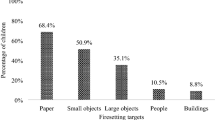Abstract
A model of firesetting risk poses that high curiosity, involvement in fire-related activities, exposure to peer/parental models, limited knowledge and skill related to fires, and poor parental supervision, among other features, are characteristic of firesetters. To operationalize several domains of the model, the Firesetting Risk Interview (FRI) for parents was developed consisting of 15 a priori dimensions. To provide a partial test of the measure and its generality across children with and without clinical dysfunction, 343 children (ages 6–13) and parents were drawn from samples of nonpatients (nonreferred), outpatients, and inpatients. In accord with the model, firesetters and nonfiresetters were found to differ in their curiosity about fire, recent involvement in fire-related activities, expression of negative emotions, early experiences with fire, exposure to others' involvement with fire, and parents' use of general disciplinary consequences. These group differences did not interact with the child's clinical status, level of antisocial behavior, or demographic background.
Similar content being viewed by others
References
American Psychiatric Association. (1980).Diagnostic and statistical manual of mental disorders (3rd ed.). Washington, DC: Author.
Awad, G., & Harrison, S. (1976). A female firesetter: A case report.Journal of Nervous and Mental Disease, 163, 432–437.
Bumpass, E. R., Fagelman, F. D., & Brix, R. J. (1983). Intervention with children who set fires.American Journal of Psychotherapy, 37, 328–345.
Chapman, L. J., Chapman, J. P., & Raulin, M. L. (1976). Scales for physical and social anhedonia.Journal of Abnormal Psychology, 85, 374–382.
Cole, R. E., Grolnick, W. S., McAndrews, M. M., Matkoski, K. M., & Schwartzman, P. I. (1986).Rochester Fire Related Youth Project, Progress Report (Vol. 2). Rochester, NY: Office of Fire Prevention and Control, New York State Department of State.
Federal Emergency Management Agency. (1979).Interviewing and counseling juvenile firesetters: The child under seven years of age. Washington, DC: U.S. Fire Administration, U.S. Government Printing Office.
Federal Emergency Management Agency. (1983).Juvenile firesetter handbook: Dealing with children ages 7–14. Washington, DC: U.S. Fire Administration, U.S. Government Printing Office.
Fineman, K. (1980). Firesetting in childhood and adolescence.Psychiatric Clinics of North America, 3, 483–500.
Gaynor, J., & Hatcher, C. (1987).The psychology of child firesetting: Detection and intervention. New York: Brunner/Mazel.
Gruber, A. R., Heck, E. T., & Mintzer, E. (1981). Children who set fires: Some background and behavioral characteristics.American Journal of Orthopsychiatry, 51, 484–488.
Jacobson, R. R. (1985a). Child firesetters: A clinical investigation.Journal of Child Psychology and Psychiatry, 26, 769–775.
Jacobson, R. R. (1985b). The subclassification of child firesetters.Journal of Child Psychology and Psychiatry, 26, 776–782.
Kafry, D. (1980). Playing with matches: Children and fire. In D. Canter (Ed.),Fires and human behaviour (pp. 47–61). Chichester, England: Wiley.
Kaufman, I., Heins, L., & Reiser, D. (1961). A re-evaluation of the psychodynamics of firesetting.American Journal of Orthopsychiatry, 31, 123–136.
Kazdin, A. E., & Esveldt-Dawson, K. (1986). The Interview for Antisocial Behavior: Psychometric characteristics and concurrent validity with child psychiatric inpatients.Journal of Psychopathology and Behavioral Assessment, 8, 289–303.
Kazdin, A. E., & Kolko, D. J. (1986). Parent psychopathology and family functioning among childhood firesetters.Journal of Abnormal Child Psychology, 14, 315–329.
Kolko, D. J. (1985). Juvenile firesetting: A review and critique.Clinical Psychology Review, 5, 345–376.
Kolko, D. J. (1989), Fire Setting and pyromania. In C. Last & M. Hersen (Eds.),Handbook of child psychiatric diagnosis (pp. 443–459). New York: Wiley.
Kolko, D. J., & Kazdin, A. E. (1986). A conceptualization of firesetting in children and adolescents.Journal of Abnormal Child Psychology, 14, 49–62.
Kolko, D. J., Kazdin, A. E. (1988a). Parent-child correspondence in identification of firesetting among child psychiatric patients.Journal of Child Psychology and Psychiatry, 29, 175–184.
Kolko, D. J., & Kazdin, A. E. (1988b). Prevalence of firesetting and related behaviors in child psychiatric patients.Journal of Consulting and Clinical Psychology, 56, 628–630.
Kolko, D. J., Kazdin, A. E., & Meyer, E. C. (1985). Aggression and psychopathology in childhood firesetters: Parent and child reports.Journal of Consulting and Clinical Psychology, 53, 377–385.
Kuhnley, E. J., Hendren, R. L., & Quinlan, D. M. (1982). Firesetting by children.Journal of the American Academy of Child Psychiatry, 21, 560–563.
Lewis, N. O. C., & Yarnell, H. (1951). Pathological firesetting (pyromania).Nervous and Mental Disease Monograph (No. 82). Nicholasville, Kentucky: Coolidge Foundation.
Loeber, R., & Schmaling, K. B. (1985). Empirical evidence for overt and covert patterns of antisocial conduct problems: A meta-analysis.Journal of Abnormal Child Psychology, 13, 337–352.
Patterson, G. R., & Bank, L. (1986). Bootstrapping your way in the nomological thicket.Behavioral Assessment, 8, 49–73.
Showers, J., & Pickrell, E. P. (1987). Child firesetters: A study of three populations.Hospital and Community Psychiatry, 38, 495–501.
Siegelman, E. Y., & Folkman, W. S. (1971).Youthful firesetters: An exploratory study in personality and background. Springfield, VA: U.S.D.A. Forest Service.
Stewart, M. A., & Culver, K. W. (1982). Children who set fires: The clinical picture and a follow-up.British Journal of Psychiatry, 140, 357–363.
Vandersall, J. A., & Wiener, J. M. (1970). Children who set fires.Archives of General Psychiatry, 22, 63–71.
Vreeland, R. G., & Levin, B. M. (1980). Psychological aspects of firesetting. In D. Canter (Ed.),Fires and human behaviour (pp. 31–46). Chichester, England: Wiley.
Wooden, W., & Berkey, M. L. (1984).Children and arson: America's middle class nightmare. New York: Plenum Press.
Author information
Authors and Affiliations
Rights and permissions
About this article
Cite this article
Kolko, D.J., Kazdin, A.E. Assessment of dimensions of childhood firesetting among patients and nonpatients: The Firesetting Risk Interview. J Abnorm Child Psychol 17, 157–176 (1989). https://doi.org/10.1007/BF00913791
Revised:
Issue Date:
DOI: https://doi.org/10.1007/BF00913791




